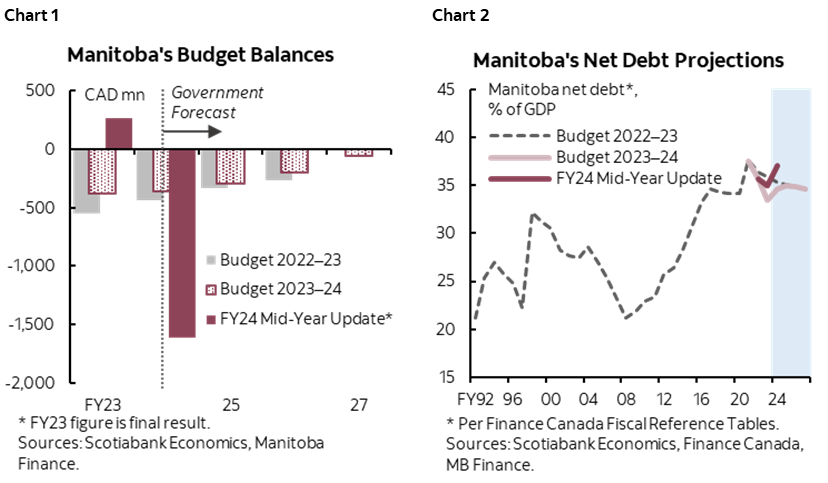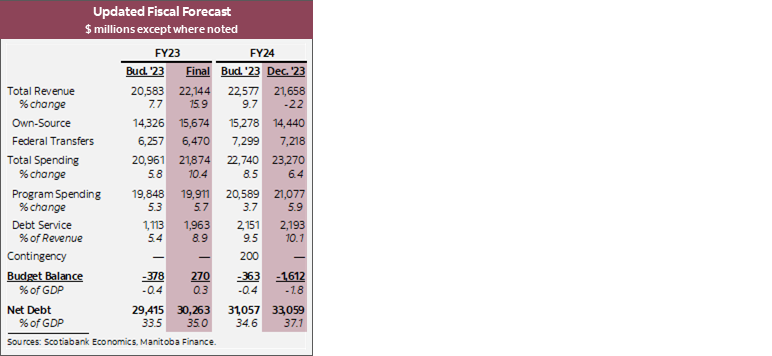A FISCAL REALITY CHECK REVEALS DEEPER RED INK
- Budget balance forecasts: -$1.6 bn (-1.8% of nominal GDP) in FY24, a deterioration of $1,249 mn versus Budget 2023 (-$363 mn, -0.4%) (chart 1).
- Net debt forecast: raised by $2 bn to $33.1 bn (37.1% of GDP) (chart 2) for FY24—highest on record excluding the exceptional FY21 affected by COVID-19—up from 34.6% projected in Budget 2023.
- Real GDP growth forecast: raised from 0.7% to 1.4% in calendar year 2023; nominal GDP forecast increased to 3.0%.
- Anticipated fiscal deterioration surpassed expectations, casting doubt on the previously outlined plan with diminishing deficits through FY26. With the net debt burden well above pre-pandemic levels and ticking back up with this mid-year update, it will be important for the province to prioritize debt reduction in its upcoming fiscal blueprint.

OUR TAKE
Manitoba’s newly elected NDP government delivered its first fiscal update with some major adjustments. The Update projects a larger FY24 shortfall of -$1.6 bn (-1.8% of nominal GDP) instead of the -$363 mn (-0.4%) projected in the province’s March fiscal blue print. This downward revision is the result of various factors, including a -5.5% dip in tax revenue linked to a reassessment-driven decrease in employment income, which has lowered the tax revenue base for 2023 and outer years. Manitoba Hydro further contributes to this downturn, projecting a -$610 mn decrease in revenue relative to Budget 2023 due to adverse effects from drought conditions. The revenue reduction suggests major deviations from prior plans to balance the books by FY29.
Despite a dimmer revenue outlook, the updated fiscal plan raised its growth assumptions, reflecting Manitoba’s economic resilience. The updated economic forecasts align with our current views, assuming real GDP to grow at 1.4% in 2023—slightly above the national average of 1.2%—before slowing to 0.8% in 2024. The $200 mn revenue contingency built into Budget 2023 has been entirely utilized to offset the substantial revenue reduction, leaving the current plan exposed to downside risks.
The update also revamped the government’s spending plan, accounting for inflation, health-care bargaining and other adjustments. While total spending has been revised up by +$530 mn (+2.3%) from Budget, almost all of the impact comes from higher than budgeted spending on Health, Seniors and Long-Term Care (+$566 mn). Increased cost pressures from wage settlements in the still-tight labour market and price inflation in medical supplies and services have added 2.5% to the Budget 2023 expenditure estimate. Absent additional spending on health and long-term care, net changes in FY24 expenditure presented in the Second Quarter update is -$36 mn relative to the initial forecast. Higher spending on debt servicing costs from higher interest rates, correctional services, as well as transportation and infrastructure is more than entirely offset by lower than projected spending on emergency expenditures, education, and consumer protection.
Mirroring the projected increase in deficit, net debt is tracking 2.5 ppts higher as a share of output at 37.1%, up from 35% in FY23. The latest update places Manitoba as the fourth highest province in debt burden, very close to the third place (Quebec), warranting a prudent and credible medium term fiscal plan in its spring budget.
A deeper fiscal shortfall implies higher borrowing requirements than the $4.7 bn forecast for FY24 at Budget time. Changes to the accounting presentation for Manitoba Hydro’s borrowings, that were first introduced in 2022/2023, include the Crown Corporation’s borrowings in debt servicing costs while the related recovery is reflected in revenue from government business enterprises. However, these changes do not impact the province’s deficit and net debt.

DISCLAIMER
This report has been prepared by Scotiabank Economics as a resource for the clients of Scotiabank. Opinions, estimates and projections contained herein are our own as of the date hereof and are subject to change without notice. The information and opinions contained herein have been compiled or arrived at from sources believed reliable but no representation or warranty, express or implied, is made as to their accuracy or completeness. Neither Scotiabank nor any of its officers, directors, partners, employees or affiliates accepts any liability whatsoever for any direct or consequential loss arising from any use of this report or its contents.
These reports are provided to you for informational purposes only. This report is not, and is not constructed as, an offer to sell or solicitation of any offer to buy any financial instrument, nor shall this report be construed as an opinion as to whether you should enter into any swap or trading strategy involving a swap or any other transaction. The information contained in this report is not intended to be, and does not constitute, a recommendation of a swap or trading strategy involving a swap within the meaning of U.S. Commodity Futures Trading Commission Regulation 23.434 and Appendix A thereto. This material is not intended to be individually tailored to your needs or characteristics and should not be viewed as a “call to action” or suggestion that you enter into a swap or trading strategy involving a swap or any other transaction. Scotiabank may engage in transactions in a manner inconsistent with the views discussed this report and may have positions, or be in the process of acquiring or disposing of positions, referred to in this report.
Scotiabank, its affiliates and any of their respective officers, directors and employees may from time to time take positions in currencies, act as managers, co-managers or underwriters of a public offering or act as principals or agents, deal in, own or act as market makers or advisors, brokers or commercial and/or investment bankers in relation to securities or related derivatives. As a result of these actions, Scotiabank may receive remuneration. All Scotiabank products and services are subject to the terms of applicable agreements and local regulations. Officers, directors and employees of Scotiabank and its affiliates may serve as directors of corporations.
Any securities discussed in this report may not be suitable for all investors. Scotiabank recommends that investors independently evaluate any issuer and security discussed in this report, and consult with any advisors they deem necessary prior to making any investment.
This report and all information, opinions and conclusions contained in it are protected by copyright. This information may not be reproduced without the prior express written consent of Scotiabank.
™ Trademark of The Bank of Nova Scotia. Used under license, where applicable.
Scotiabank, together with “Global Banking and Markets”, is a marketing name for the global corporate and investment banking and capital markets businesses of The Bank of Nova Scotia and certain of its affiliates in the countries where they operate, including; Scotiabank Europe plc; Scotiabank (Ireland) Designated Activity Company; Scotiabank Inverlat S.A., Institución de Banca Múltiple, Grupo Financiero Scotiabank Inverlat, Scotia Inverlat Casa de Bolsa, S.A. de C.V., Grupo Financiero Scotiabank Inverlat, Scotia Inverlat Derivados S.A. de C.V. – all members of the Scotiabank group and authorized users of the Scotiabank mark. The Bank of Nova Scotia is incorporated in Canada with limited liability and is authorised and regulated by the Office of the Superintendent of Financial Institutions Canada. The Bank of Nova Scotia is authorized by the UK Prudential Regulation Authority and is subject to regulation by the UK Financial Conduct Authority and limited regulation by the UK Prudential Regulation Authority. Details about the extent of The Bank of Nova Scotia's regulation by the UK Prudential Regulation Authority are available from us on request. Scotiabank Europe plc is authorized by the UK Prudential Regulation Authority and regulated by the UK Financial Conduct Authority and the UK Prudential Regulation Authority.
Scotiabank Inverlat, S.A., Scotia Inverlat Casa de Bolsa, S.A. de C.V, Grupo Financiero Scotiabank Inverlat, and Scotia Inverlat Derivados, S.A. de C.V., are each authorized and regulated by the Mexican financial authorities.
Not all products and services are offered in all jurisdictions. Services described are available in jurisdictions where permitted by law.

